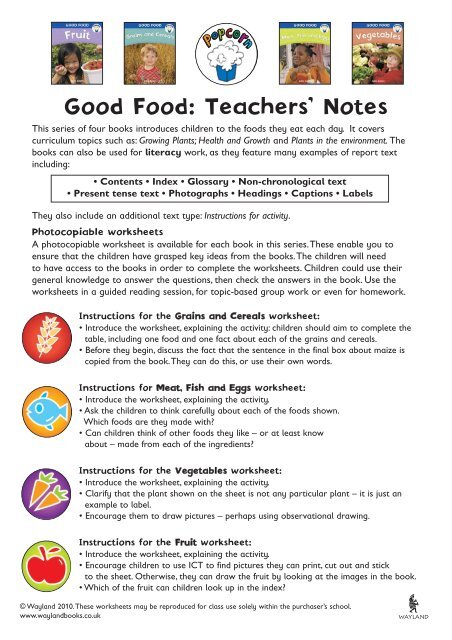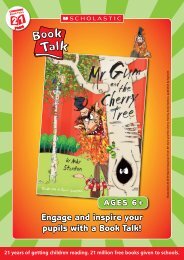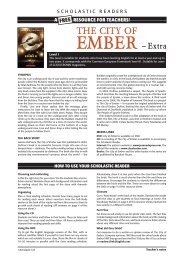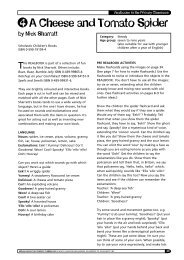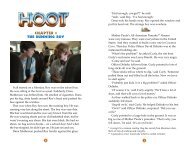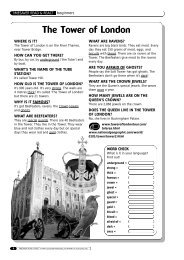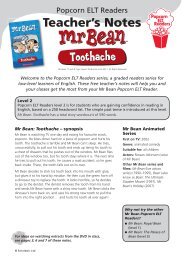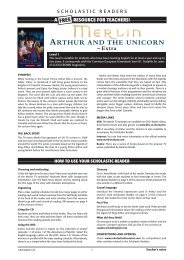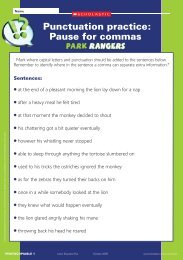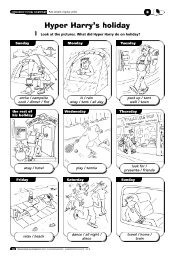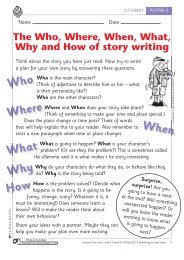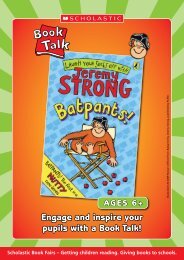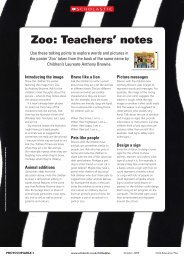Good Food: Teachers' Notes - Scholastic
Good Food: Teachers' Notes - Scholastic
Good Food: Teachers' Notes - Scholastic
Create successful ePaper yourself
Turn your PDF publications into a flip-book with our unique Google optimized e-Paper software.
<strong>Good</strong> <strong>Food</strong>: Teachers’ <strong>Notes</strong><br />
This series of four books introduces children to the foods they eat each day. It covers<br />
curriculum topics such as: Growing Plants; Health and Growth and Plants in the environment. The<br />
books can also be used for literacy work, as they feature many examples of report text<br />
including:<br />
• Contents • Index • Glossary • Non-chronological text<br />
• Present tense text • Photographs • Headings • Captions • Labels<br />
They also include an additional text type: Instructions for activity.<br />
Photocopiable worksheets<br />
A photocopiable worksheet is available for each book in this series. These enable you to<br />
ensure that the children have grasped key ideas from the books. The children will need<br />
to have access to the books in order to complete the worksheets. Children could use their<br />
general knowledge to answer the questions, then check the answers in the book. Use the<br />
worksheets in a guided reading session, for topic-based group work or even for homework.<br />
Instructions for the Grains and Cereals worksheet:<br />
• Introduce the worksheet, explaining the activity: children should aim to complete the<br />
table, including one food and one fact about each of the grains and cereals.<br />
• Before they begin, discuss the fact that the sentence in the final box about maize is<br />
copied from the book. They can do this, or use their own words.<br />
Instructions for Meat, Fish and Eggs worksheet:<br />
• Introduce the worksheet, explaining the activity.<br />
• Ask the children to think carefully about each of the foods shown.<br />
Which foods are they made with<br />
• Can children think of other foods they like – or at least know<br />
about – made from each of the ingredients<br />
Instructions for the Vegetables worksheet:<br />
• Introduce the worksheet, explaining the activity.<br />
• Clarify that the plant shown on the sheet is not any particular plant – it is just an<br />
example to label.<br />
• Encourage them to draw pictures – perhaps using observational drawing.<br />
Instructions for the Fruit worksheet:<br />
• Introduce the worksheet, explaining the activity.<br />
• Encourage children to use ICT to find pictures they can print, cut out and stick<br />
to the sheet. Otherwise, they can draw the fruit by looking at the images in the book.<br />
• Which of the fruit can children look up in the index<br />
© Wayland 2010. These worksheets may be reproduced for class use solely within the purchaser’s school.<br />
www.waylandbooks.co.uk
Name<br />
<strong>Good</strong> <strong>Food</strong>: Fruit<br />
Date<br />
• Read the fruit names.<br />
• Find a picture of each fruit in the book and draw it above its<br />
name, or find a picture on the internet and stick it on the page.<br />
apple<br />
banana<br />
orange<br />
melon<br />
pineapple<br />
kiwi fruit<br />
grapes<br />
strawberry<br />
coconut<br />
Learning objective: To find and draw images of fruit.<br />
© Wayland 2010. These worksheets may be reproduced for class use solely within the purchaser’s school.<br />
www.waylandbooks.co.uk
Name<br />
<strong>Good</strong> <strong>Food</strong>: Grains and Cereals<br />
Date<br />
• Write one food and one fact for each of these grains<br />
and cereals. One is done for you.<br />
Cereal or grain <strong>Food</strong> Fact<br />
Barley<br />
Maize<br />
cornflakes<br />
Maize kernels can also be heated<br />
to make popcorn.<br />
Rye<br />
Rice<br />
Wheat<br />
Oats<br />
Learning objective: To find out how we eat grains and cereals.<br />
© Wayland 2010. These worksheets may be reproduced for class use solely within the purchaser’s school.<br />
www.waylandbooks.co.uk
Name<br />
<strong>Good</strong> <strong>Food</strong>: Meat, Fish and Eggs<br />
Date<br />
• Cut out the pictures.<br />
• Decide whether each picture is about meat, fish or eggs.<br />
• Stick the pictures around the headings.<br />
eggs fish meat<br />
Draw food you like<br />
with meat.<br />
Draw food you like<br />
with fish.<br />
Draw food you like<br />
with eggs.<br />
Learning objective: To think about how we eat different foods.<br />
© Wayland 2010. These worksheets may be reproduced for class use solely within the purchaser’s school.<br />
www.waylandbooks.co.uk
Name<br />
<strong>Good</strong> <strong>Food</strong>: Vegetables<br />
Date<br />
• Different vegetables are different parts of the plant.<br />
• Draw lines to match the name of each vegetable to<br />
the part of the plant.<br />
• Draw pictures of the vegetables.<br />
celery<br />
broccoli<br />
flower<br />
cauliflower<br />
spinach<br />
leaves<br />
cabbage<br />
asparagus<br />
stem<br />
turnips<br />
potatoes<br />
tuber<br />
parsnips<br />
roots<br />
carrots<br />
Learning objective: To find information in the book and draw images of vegetables.<br />
© Wayland 2010. These worksheets may be reproduced for class use solely within the purchaser’s school.<br />
www.waylandbooks.co.uk


